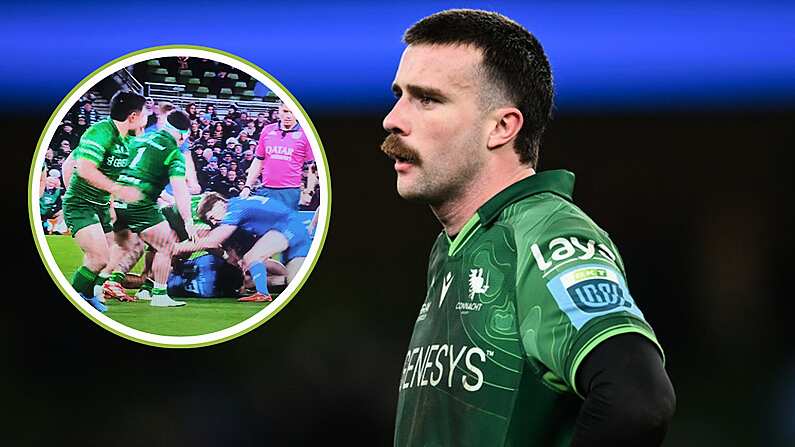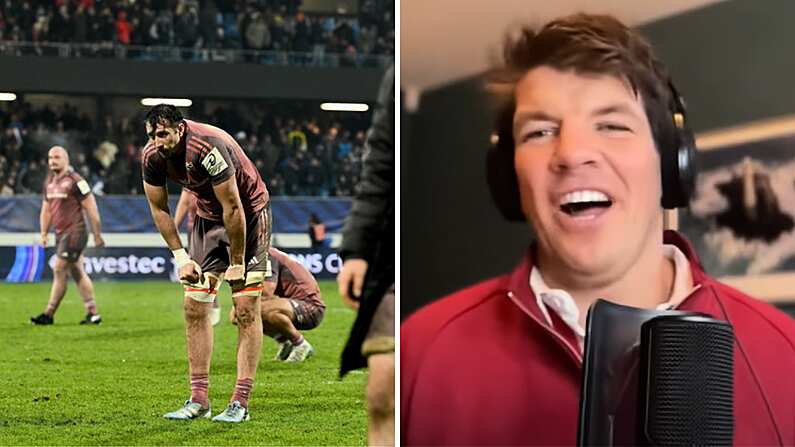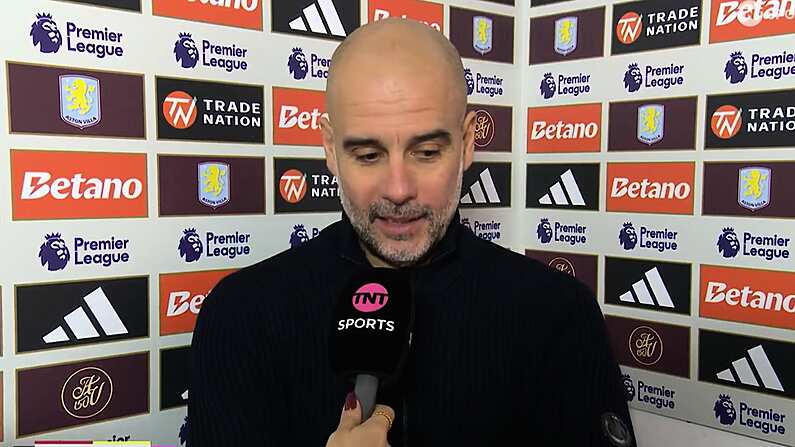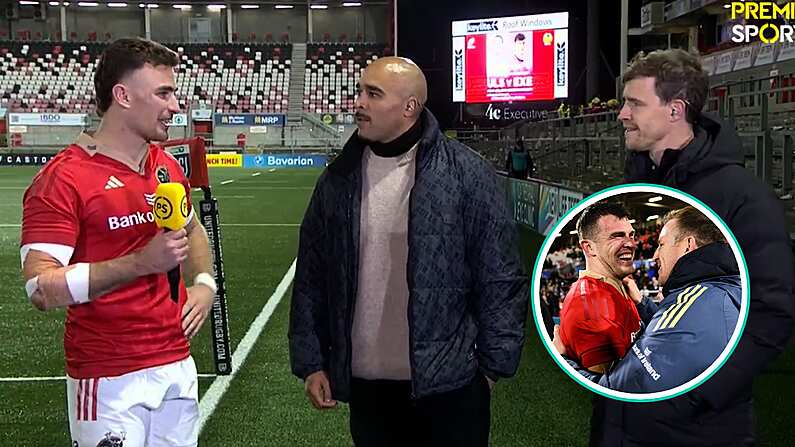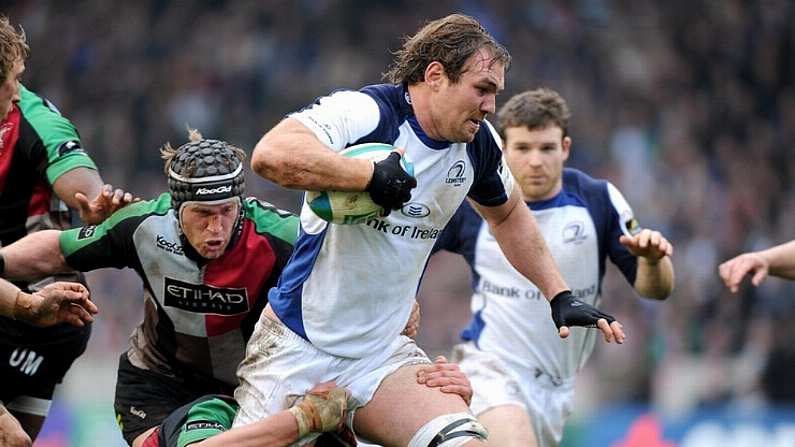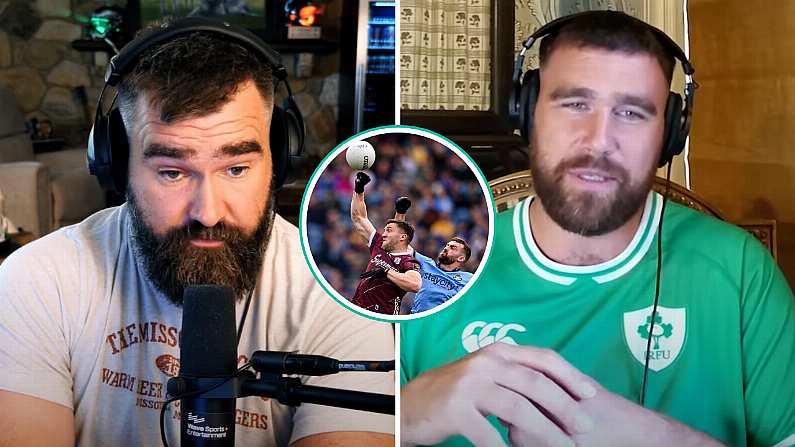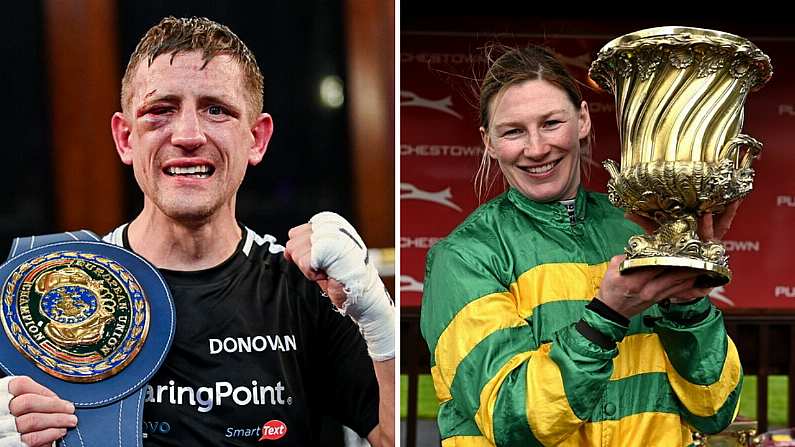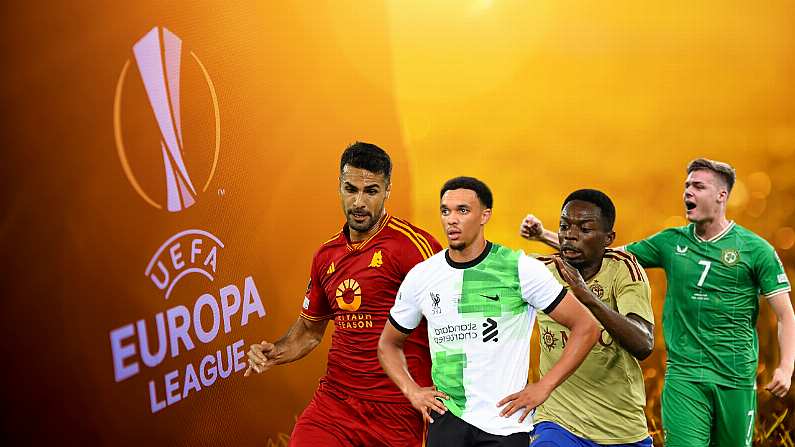As a teenager in Tralee, Brendan Moran sold pictures to local papers The Kerryman, The Kerry's Eye and The Kingdom.
Straight out of college in Dun Laoghaire, he joined Sportsfile. 26 years on, he is recognised as one of Ireland's best sports photographers.
Search for his name on the Sportsfile website and you'll be hit with over 180,000 results. Consider that number when knowing we asked him to reduce a quarter of a century of work to just a handful of favourites.
'One of the greatest pictures of my career'
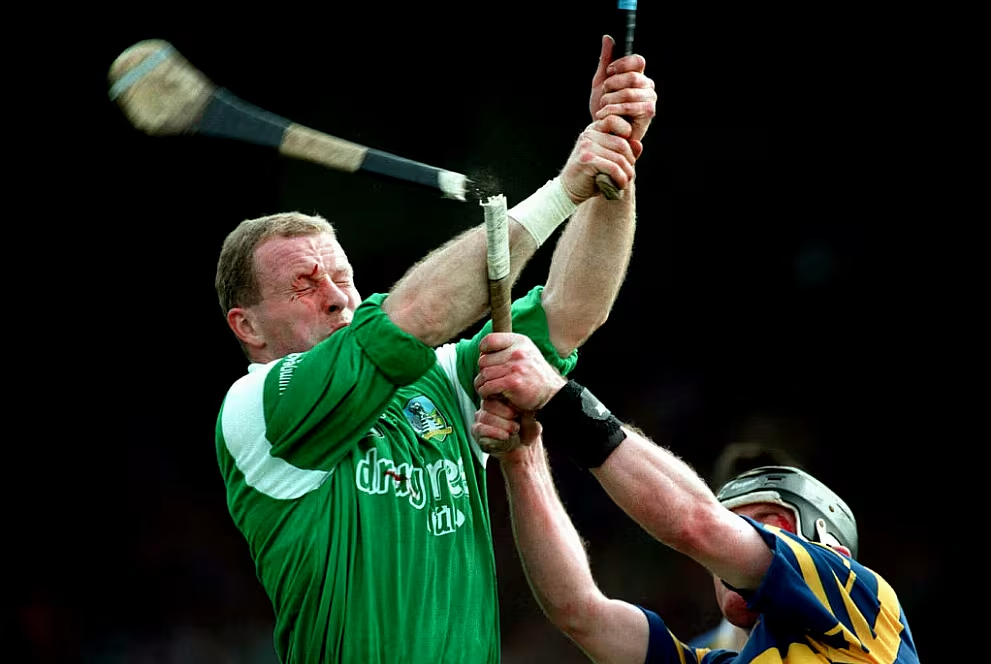
13 April 1997; Stephen McDonagh of Limerick in action against Aidan Flanagan of Tipperary during a National Hurling League Division 1 match at the Gaelic Grounds in Limerick.
"In some ways, it defies some of the rules of photography," says Moran of the shot he took during a 1997 league game between Limerick and Tipp.
Aidan Flanagan is wearing a helmet without a faceguard. Stephen McDonagh isn't even wearing a helmet. For young fans, it would be as strange a sight as a car without seatbelts.
There would be that 'No ball, no picture' but sometimes something happens where there might be no ball but it's an outstanding picture.
The way hurling has changed, you don't see people pulling over their heads anymore. The likelihood of that happening is rare.
This would be one of the greatest pictures of my career but it's 23 years ago, which is hard to imagine. I'd be hugely proud of the picture.
While I've covered thousands of hurling matches since, and photographers left, right and centre have, there's not many pictures that beat it: You literally have the broken hurley, the bit of dust, and you can see that Stephen McDonagh has a little cut on his face.
I would have been buzzing. It would have been used in the papers the following day. I think the Irish Times went half a page with it which rarely happens with pictures.
You'd always be trying to get something as good as it but I don't know if it'll ever happen.
Moran was in his early 20s when he snapped it. Just like hurling, it was also a different era of photography with rolls of film being used and so a limit on how many pictures he could take.
That picture, along with one other, was the genesis for 'A Season Of Sundays' in the mind of Sportsfile founder Ray McManus. The book, an annual photographic chronicle of the GAA year, last year saw its 23rd edition. Moran's shot of Aidan Flanagan's broken hurley was the first cover photo.
"I would have been allocated maybe three or four rolls for that match, maybe five at a push," he says.
"Five rolls of film is 180 pictures. Now, you'd have 180 pictures taken before the teams run out on the field.
"Your timing had to be spot on because you couldn't see if the picture was any good. You just took pictures as you went along.
"I would have gone to that game on my own, got the film processed, and just sent it back to Dublin."
'It was a brilliant thrill, the relief of seeing the picture'

19 August 1998. Ireland's Sonia O'Sullivan celebrates her victory in the women's 10,000m final at the European Athletics Championships, Nepstadion, Budapest, Hungary.
The trip to Budapest in the summer of 1998 was Moran's first solo job abroad to cover an athletics championships. Though he was without work colleagues, Ray McManus ensured he was not without advice.
"I actually travelled with well-known athletics fans, Sean Callan and Harry Gorman," he says.
"Ray would have been pally with them. They were [saying], 'Come with us, we'll show you where to go'. They would have been to loads of events. Harry was at the Olympics in 1964.
"I stayed in a B&B somewhere in Budapest. Back in them days, we had to carry film processing [equipment] and all sorts of manner of baggage with us."
The championships was a successful one for Ireland. Three medals came home: A bronze for Marcus O'Carroll in the 5,000m and golds for Sonia O'Sullivan in the 5,000m and 10,000m.
1998 was a real comeback year for O'Sullivan. She'd suffered disappointed at the 1996 Olympics in Atlanta and at the 1997 World Championships in Athens.
"That night, as soon as she crossed the line," Moran says, "I hoped I had a picture but until I actually went back to my B&B and processed the film, and looked at the film, I didn't really know if I had it.
"I was in my early 20s and there would have been a lot of pressure on me. I suppose my heart was in my mouth all the way back in the taxi to the B&B. There were a couple of bad frames as well but this was the best of them.
"We mainly went to cover Sonia. The fact that it was evening time, the women's 10,000m final would have been late enough - there was a little bit of pressure on. I had an hour because Hungary was an hour ahead.
"It would have been the days where wiring or sending photographs was fairly new around that time. It was only in the mid-90s that it became affordable to send pictures from abroad. Before then, it was only the major wire services, AP and Reuters, that sent pictures.
"It was a brilliant thrill, the relief of seeing the picture. It got used and it won in the Press Photographers Awards.
"When you look back over the years of photographing athletes, it's always nice to get one good picture of the iconic Irish athletes."
'I just decided to take a chance and go up onto the steps'

30 January 1999; Ulster captain David Humphreys is lifted by his teammates after their side's victory. Heineken European Cup final, Ulster v Colomiers, Lansdowne Road, Dublin.
On a date which seems strange now - January 30th - Ulster took on French side Colomiers in the 1999 European Cup final. It was the fourth year of the tournament and it was without the slickness of its modern iterations.
"In the old Lansdowne Road, above the players' tunnel, there was a walkway where they would present trophies," says Moran.
"I just decided to take a chance and go up onto the steps."
As with other forms of journalism, building relationships pays off.
"I would have known David Humphries. We would have worked together a couple of times. Irish sports personalities are very good in that they would know the sports photographers because they'd run into them regularly enough. They know that we're there to record them.
"They did a photo facing the other way for all the photographers but I wanted to get something with all the fans behind.
"Just before they went down the steps, I managed to attract his attention and he held up the flag and the cup. It made a nicer picture because it has the scoreboard, it has Lansdowne Road and all the fans.
"It just summed the match up and got used extensively the following day.
"You take loads of rubbish - every sports photographer will tell you that - but it's nice to get a good one of quite a historic [moment]. I was one of only two photographers to get it."
'He was the hero, it was a lovely picture for me to get'

24 September, 2006; Darren Clarke holding the Ryder Cup after Europe's 2006 victory in the K Club.
Golf photography is hard work. While carrying 15kg of equipment, a photographer could walk 20km.
That was Moran's life for three days in September 2006. Those were major ones in the history of Irish sport: The Ryder Cup was being held in Ireland - at the K Club - for the first time.
Darren Clarke, whose wife Heather had died six weeks before the competition, was the star for Europe, winning three points from three matches over an emotional weekend.
"I got the winning putt," says Moran.
"I can't remember the golfer's name, nobody really cares because the story was about Darren Clarke. He was the story of the day, he was the story of the Ryder Cup.
"I had colleagues following and photographing him on the 16th but I was away down on 17. There wasn't a huge crowd there, your man sunk the putt and they won.
"We went back to the clubhouse and I still didn't really have a good picture. They had built the stage for the presentation. My colleagues were more centred and looking ahead straight on where they do the team picture and hand over the trophy.
"I just went off and wandered around. The weather that day was awful. I just happened to get an angle in the stand where the sun was backlighting Darren. I took a chance on a picture. There are lots of pictures that are bright and show them getting the cup.
"Darren had a fairly funky hairdo back then. Everybody knew him by sight. You don't have to see his face in the picture; everybody knows what the Ryder Cup looks like and because it was [held] in Ireland and Europe won it, and he was the hero, it was a lovely picture for me to get.
"It was something a little bit different. At a lot of these mass events where you have loads of photographers, everybody gets quite similar pictures. To come away with something a bit unusual was nice."
'A lot of elements came together'

22 September 2013; Mayo's goalkeeper Robert Hennelly, left, Colm Boyle and Aidan O'Shea during the presentation of the Sam Maguire amid heavy smoke from after match fireworks.
Nearly 20 years into his sports photography career, and having enough colleagues to get the fundamental shots of an All-Ireland final day, Moran knew he didn't have to be the one snapping Sam Maguire being lifted by Stephen Cluxton.
Instead, he was on the lookout for something special, and he found it. In the world of Irish sport, shooting a different moment of Mayo football misery is like trying to capture a unique grain of sand, but that is what he did.
Mayo had lost their second All-Ireland final in a row, and their seventh in 25 years. In a confluence of luck, experience, instinct and knowledge, Moran caught a moment which encapsulated the beauty and tragedy of Mayo's quest.
"I don't mind taking a loose brief at the end of a match," says Moran.
"I was just floating around looking out for a picture. I didn't really have anything specific to take because we'd have people detailed to do the dejection of one team and people to do the celebration of the other team.
"A lot of elements came together: The fireworks go off so you can't stand out in the middle of the pitch and the smoke just lingered a bit for maybe 30 seconds, there wasn't much rain or wind. Then the sun just appeared through.
"It was just about trying to get an angle on it then. The light coming through the roof makes that picture.
"As a photographer, you look at the scene and if you took out the Mayo players, you'd love for something brilliant to happen in it. You could imagine it in your head but having all the elements to come together [is unlikely].
"I just happened to be lucky that Rob Hennelly has his head down; Colm Boyle and Aidan O'Shea, you can see by their body language straight away that they've lost. You don't need the scoreboard or the other team celebrating, you just know by looking at it.
"Hopefully, we'll get that light again when Mayo eventually win it because it would be an even better picture."
'A handful of photographers that got the best pictures that night'

24 May, 2014; Real Madrid's Cristiano Ronaldo celebrates after scoring his side's fourth goal during the 2014 UEFA Champions League final against Atletico Madrid
UEFA has been a client of Sportsfile for the past 15 years or so. It is that relationship which has seen Moran step outside the realm of Irish sport and into European football. It isn't always about the glitzy big days. They also shoot youth football tournaments, futsal, and more.
Still, Moran and his camera bag have been to 10 Champions League finals.
"It has changed over the years - it used to just be for their website but now it goes across a lot more publications," he says.
2014 saw him land in Lisbon as Real Madrid took on city rivals Atletico on European football's big night. An Estádio da Luz upgrade - the installation of a new WiFi system - caused minor trouble for fans but major problems for the press.
That final, all the goals were at one end. The celebrations were all in the same corner. If I'd been sitting somewhere else, I would have had no goal celebrations and I'd have no goal pictures.
I happened to be one of eight to 10 photographers in that corner. The likes of AP, Getty, the club photographers [were there]. It would only have been a handful of photographers that got the best pictures that night. It was hugely frustrating for the other 180 at the match.
It was one of the first times that I understood the guys who do this day in, day out at Champions League. They're all in competition.
When we're sitting behind the goal, everybody has a chair but that's all you have; you don't have room to the left or right. Any baggage has to go behind you; you can't use a laptop because there's no room. All the other room behind the goal is taken up by television rights holders.
That night, Gareth Bale scored a goal as well. There was a photographer beside me from the UK and the guy beside him was from Real Madrid. Because the guy from Real Madrid was fiddling around between a big lens and a small lens, the photographer from the UK missed the picture of the Bale goal. That would have been a huge picture for him to have because it was a UK player. There was a lot of choice language between those chaps.
There's nothing you can do about it. When you're working together like that, every photographer has to move in the same direction at the same time; we've got big lenses and small lenses and you have to know how to work in that scenario.
When Ronaldo scored, the presentation was going to happen straight afterwards. Because the WiFi was a bit dodgy that day, some of the agencies had runners to run with their [SD] cards up to the press room. It was a lot more manic and chaotic compared to any other year I've been at it.
Of all the agencies that sit there - AP, Reuters, Getty, AFP, EPA - the first out with the picture at that hour of the night probably gets used everywhere.
It is highly stressful at that level when you're at the biggest game in the world and everyone is watching it on television. There's an enormous amount of pressure because there's no replay. If you get blocked, maybe a steward stands in your way, you're in trouble. It's the one part of journalism where you don't have a second chance.
When a photographer is looking to capture a moment, it helps - sometimes - that the subject has an appreciation for the attention which is on them.
"Ronaldo is great for a picture. If you're at an event where he's at, there's definitely going to be a picture in it because he's very aware of the cameras; he knows his image and the value of it. Other players wouldn't necessarily be like that."
'It is a picture that every time I look at it, I wince a little bit'

21 June 2015; Seamus Callanan, Tipperary, is challenged by Limerick goalkeeper Barry Hennessy, a clash which saw Callanan lose three teeth and leave the pitch for a blood injury before returning late in the game. Munster Senior Hurling Championship semi-final, Gaelic Grounds, Limerick.
It took a while for the reality of what he'd captured in 2015 Munster semi-final between Limerick and Tipperary to hit Brendan Moran.
"When I saw this picture first, I thought his teeth were just saliva coming out of his mouth," he says.
"He went off, got stitches and he came back on. It was only after the match that I realised - when I looked at it a lot closer - 'Are they his teeth? They are his teeth'.
"Seamus, he has a copy of the picture. It was obviously totally accidental in that Barry Hennessy ran out and went to challenge him and the front of his helmet happened to catch the front of Seamus's guard.
"It's amazing to think that he just went off, got a few stitches, came back on and kept playing, which I just think is mad. There are very few sports where if a fella lost a couple of teeth, he just comes back on.
"Seamus has got to be in work that week. He's got to get a dentist and get prosthetics or whatever. I'd have huge admiration for him playing on like that - I don't think I could do it.
"With the likes of this picture, I would have made sure that I sat in a certain position, that the background was dark if anything happened. If most of the picture is white, it's difficult to pick up on the detail in the middle.
"That's the way Ray taught me back in the day and the way we'd always try to teach our lads as they are coming through.
"Any day we go out, we just do our homework. If I go to something that I'm not familiar with, you might talk to a couple of people who would point you in the right direction: Who's the main person here? What should we look out for? If you stack the odds in your favour, when luck comes along, then that's when you'll get a really good picture.
"That's the pleasing aspect about it. I don't think that anybody on television or the radio or the journalists would ever have seen this. [They'd say] 'Seamus, oh, he's gone off' but nobody knows what's happened. When you get a picture where everybody goes, 'Oh, Jaysus, look at that' - everybody is attracted to it.
"You try to get something which makes people look at it a second time and go, 'Wow, look at that'. That's why we do sport and don't go out doing weddings - that's a different genre. I like the thrill of sport and that's why I've done it for so long.
"It is a picture that every time I look at it, I wince a little bit because I'm imagining myself in the same situation - I definitely wouldn't have come back on the field anyway. Seamus is made of hard stuff."
'It's a difficult picture but I'm glad somebody took it'

22 October 2016; Munster's Simon Zebo sheds a tear, while the comforting hand of captain Peter O'Mahony rests on his shoulder, during a minute's silence in memory of the late Munster Rugby head coach Anthony Foley before a European Rugby Champions Cup pool match against Glasgow Warriors at Thomond Park in Limerick.
Six days after the death of Munster coach Anthony Foley, the province's players stepped onto the pitch for a Champions Cup game.
The emotion wasn't just raw, or blue, it was more than that, it was just cut from the animal, still bleeding like the tears which fell from Simon Zebo's eye.
"I would have photographed Anthony as a player and as a coach," Moran says.
"I was hugely saddened by his passing but at the end of the day, everyone has to get on with their job and the players were in a European Cup game, so they had to get on with their job.
"For them to play a week after Anthony's passing... the funeral had only been Thursday or Friday... it was difficult for them, I have no doubt.
"We'd been told that the fans in one of the stands would hold up 'Axel 8' over their heads in a montage of paper. We knew that there was going to be a picture in this.
"Myself and my colleague Diarmuid Greene, we kind of split: He was going to do the 'Axel 8' in the far stand, and we figured that was going to be the picture of the day.
"The minute's silence was on, and you're watching out for a picture but you don't really know what's happening; You're concentrating on players here and there, and some aren't showing any emotion, some are.
"It's only 60 seconds and you try to get as many pictures as you can out of it; sum it up in many different angles.
"This is probably one of the last frames I took before I took my position at the end of the field. It was only when the game had kicked off and I started reviewing the pictures on my laptop that I found this picture. You're trying to do two things at the same time.
"It was the office that converted it to black and white. At half-time, I looked at the internet and I saw this picture and said, 'Wow, that's great'.
"A great picture on the day, very sad in lots of ways, but it's become quite iconic about it: It shows the love that the players and the club had for Anthony.
"It's a difficult picture, in lots of ways, but I'm glad somebody took it. Whether it was me or somebody else, it's good that it was taken."
'I was following Devin, he turned around and there was Joe'

5 November 2016; Head coach Joe Schmidt and Devin Toner celebrate victory after Ireland beat the All Blacks for the first time at Soldier Field in Chicago.
Brendan Moran has covered Irish rugby since the early days of the professional game. He's seen many firsts: The greatest might be Ireland's win against the All Blacks in Chicago. On that day, he caught a moment which captured it all.
"When they won the game, the All Blacks are pottering around going 'That's grand. Sure we'll play them in a couple of weeks'," he says.
"Ireland did so well that day, and a lot of the players did very well; you're looking around and there's players hugging and players waving to the crowd. You're running around trying to get as much as you can.
"Rarely would you get Joe doing anything after a match. Joe is very reserved. He doesn't get carried away an awful lot in my experience. So much so that people don't bother photographing him after a match because he's just standing there and he's quite controlled. You look for players and people showing a bit of emotion.
"It just happened that I was following Devin and he turned around and there was Joe. He was just like, 'Put it there'.
"While there are a lot of pictures from the game, there are not many that by looking at the picture in one go you can know we beat the All Blacks 40-29, it was in Soldier Field and 'Jesus, Joe's reacting to something. It must be good'."
*********

15 February 2019; Sportsfile photographers Brendan Moran, left, and Stephen McCarthy after the Press Photographers Association of Ireland Awards at the Ballsbridge Hotel in Dublin. Photo by Ray McManus / SPORTSFILE
"We have an old collection called 'The Connolly Collection' in our place," Moran says.
"I saw today old pictures of Liam Brady playing and a picture of Arkle in 1965. Jim Connolly who took the pictures back then is going, 'That's grand' but it's only now when people look back on it [that they really appreciate it].
"In 30 or 40 years time when people are looking back on my pictures and Sportsfile pictures, they'll be going, 'Jaysus, look at what they were wearing. Look at the haircuts at the time'.
"The world moves on but it's important for us, I believe, to do stuff for historical reasons.
"Getting paid to be in the front row of sports events, there could be worse jobs."
Ireland's 2007 Grand Slam-Winning U20 Team: Where Are They Now?



